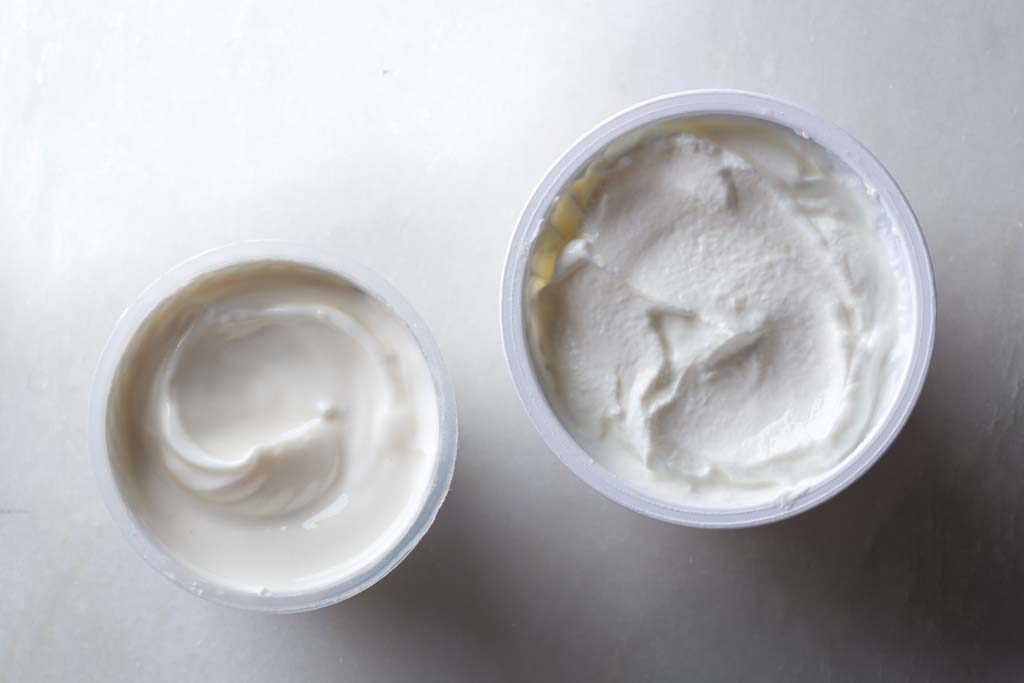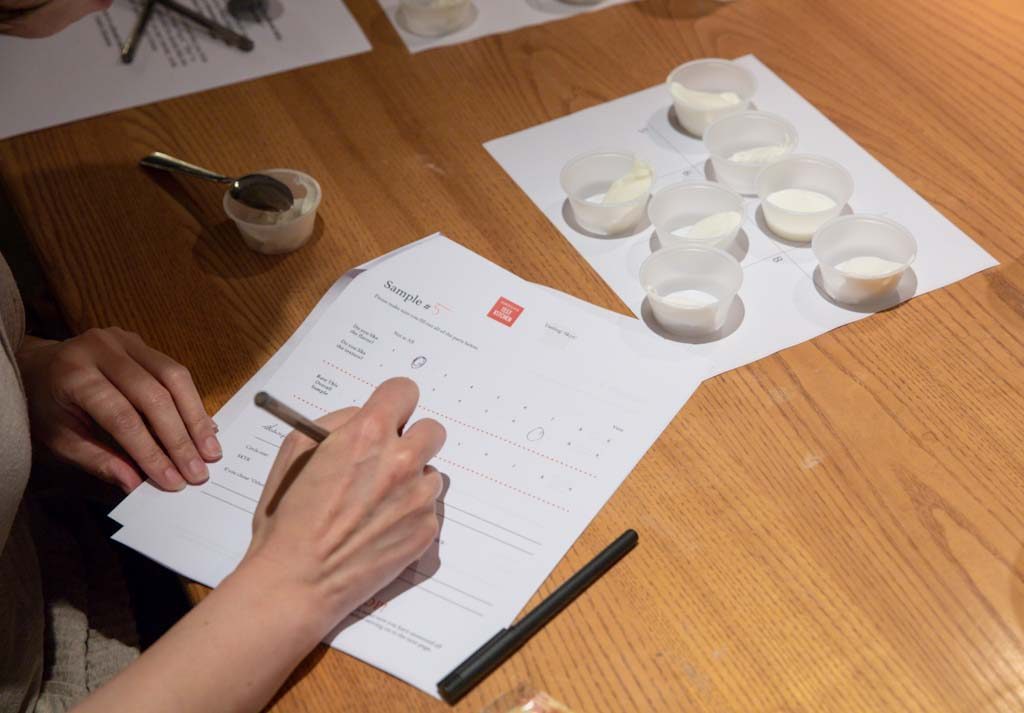Thick, full of protein, and allegedly very good for you, skyr is a relative newcomer to the shelves of American grocery stores. It’s been made in Iceland for more than a thousand years, so we’re a little late to the game.
In America, skyr is found in the yogurt aisle and is labeled as yogurt. However, if you are lucky enough to visit Iceland, people there will tell you that skyr is not a yogurt at all, but rather a cheese.
So which is it? Is skyr a cheese or just another strained yogurt presented in a sleek, Nordic package? The answers to these questions reveal there’s much more to skyr than meets the eye.
To learn about skyr from someone who knows their skyr, I called Gunnar Karl Gíslason, acclaimed chef at New York City’s Agern restaurant and author of North: The New Nordic Cuisine of Iceland. His earliest memories of skyr are with his grandfather, who ate very sour “old” skyr for lunch every day. To Gíslason, the best way to eat skyr is simple: cold with cream and fresh fruit.
Skyr is a central part of the Icelandic diet and is intimately tied to Icelandic culture. It was likely brought to Iceland by the Scandinavian Norsemen who settled the land in the late ninth century. Like the beautiful Icelandic horse, skyr disappeared from the rest of the Nordic region, but in Iceland, it continued to evolve into the unique product it is today.
To help preserve the history of skyr, a Slow Food Foundation for Biodiversity presidium, or small research group, formed in 2015 to study the processes and ingredients of traditionally produced skyr, as well as to promote interest in Iceland. I asked the coordinator of the presidium, Dominique Plédel Jónsson, about the traditional skyr-making process.
The traditional recipe for skyr involves taking milk (skim or low-fat) and heating it with a bit of old skyr from a previous batch, which is added as a starter, Jónsson explained. Rennet may also be added, and after curds form, the whey is drained slowly for many hours to create a thick, sour product.
Rennet? That sounds a lot like cheese.
But what about the skyr sold in the United States? Are these products the same as the traditional Icelandic version? Are they pale imitations or modern takes on an ancient food?
I spoke with Smári Ásmundsson, CEO and founder of Smári Organics, an American skyr company distributed nationally. He said their recipe was developed from the knowledge accrued from a decade of home skyr making and many long conversations with an expert Icelandic skyr maker (and family friend). The Smári Organics recipe follows the same basic outline as the traditional recipe, with one important difference: Half of their products are made from whole milk (rather than skim or lowfat). Ásmundsson likes to call his product Icelandic yogurt, instead of skyr, for this reason. “After a thousand years of making skyr,” he said, “we revolutionized skyr making by making it with whole milk.” In addition to their whole-milk products, Smári Organics also sells more traditional skyrs made with skim milk.
It certainly makes sense to market skyr as a yogurt in the United States. “Yogurt’s doing very well,” said Jim Carper, editor in chief of the industry publication Dairy Foods. In recent years, the yogurt industry has seen significant growth: The U.S. Department of Agriculture’s National Agricultural Statistics Service reported an increase in yogurt production from 4.1 billion pounds in 2010 to 4.7 billion pounds in 2014.
According to Carper, the arrival of Greek yogurt on the scene helped to drive that growth. “When Greek yogurt took off in popularity, that really, really raised the profile of cultured dairy, yogurt-type products.” In 2007, Greek yogurt had a measly 1 percent share of the yogurt market; today it commands more than 50 percent. Consumers are drawn to the protein-rich items in the dairy aisle, not only because they taste good, but also because experts stress their nutritional value.
Most skyrs contain more than 20 grams of protein per cup, with little to no fat or added sugars. And to pioneering skyr makers in America, health concerns are both motivators as well as useful marketing tools.

Ásmundsson set out “to create the healthiest yogurt in America” after becoming a dad, he said. Siggi’s, also founded by an Icelandic transplant, and Icelandic Provisions, founded by Iceland’s major dairy distributer (MS Iceland Dairies, or Mjólkursamsalan) and an American venture capital firm, are other prominent players in the U.S. skyr market that also loudly tout their products’ health benefits. There’s even a new, drinkable entry from B’More Organic, founded by self-described health nut Andrew Buerger. Buerger said he realized skyr could be his life’s work when he tried it on a climbing expedition in Iceland. “I came back to the States and I called a dairy scientist,” he told me. “I said, ‘I’ve got this recipe that I want to make: traditional skyr with no added sugar.’” (They use stevia.)
But if it’s marketed as yogurt, does that mean it is truly yogurt? The Slow Food Foundation for Biodiversity presidium defines skyr as a “fresh, acid-set cheese.” Quark and fromage blanc are also spoonable, fresh cheeses. But we call Greek yogurt a yogurt. So why call skyr a cheese, if it tastes like and has the texture of yogurt? And for that matter, why do we call fresh, spoonable fermented dairy products, like quark, cheese?
To determine where one draws the line between a yogurt and a cheese, I spoke to a dairy expert: Dr. Lisbeth Goddik, professor in the Department of Food Science and Technology at Oregon State University and a specialist in their Dairy Processing extension program. In the United States, she said that skyr does not have any specific regulatory guidelines: “If they call it skyr, they can basically do whatever they want.” However, if someone wants to slap a cheese or yogurt label on their packaged skyr, more rules would apply. She said that the basic guidelines in the United States regarding products labeled as either yogurt or cheese are spelled out in the Code of Federal Regulations (CFR). The CFR stipulates that if something is going to be called yogurt, it must be fermented with the two yogurt bacteria, namely Streptococcus thermophilus and Lactobacillus delbrueckii subspecies bulgaricus.
Dr. Thora Valsdóttir, a scientist working with the Slow Food Foundation for Biodiversity presidium, conducted preliminary microbiological studies of traditionally and industrially produced skyr several years ago. She had the hypothesis that traditionally made skyr would have higher bacterial diversity because traditional fermentation is started by adding a little bit of old skyr from the last batch—an ill-defined mixture of bacteria and yeasts—whereas many industrial skyrs are inoculated with precisely defined mixtures of bacteria and the fermentation is controlled such that yeasts do not grow. The results of the study matched these predictions: The traditional skyr had a much higher diversity of bacteria than did the industrial skyr.
But were the official CFR yogurt bacteria species present? While Valsdóttir stressed that her results were part of a very preliminary study that should be confirmed by rigorous follow-up experiments, she reported that they did indeed find the usual yogurt suspects in all of the skyrs they tested, both traditional and industrial.
So skyr is yogurt. Right?
I asked Goddik if the addition of rennet disqualified skyr from joining the ranks of true yogurts. She laughed, “Oh dear, that’s a good question.” While the CFR doesn’t say anything about rennet in its definitions of yogurt, Goddik said, once you add rennet, you tend to think of it as a cheese. But many cheeses, such as ricotta, are made without rennet. “So you’re still somewhere in no-man’s-land with this type of product.”
Rennet is conspicuously absent from the ingredient lists of skyr products available in the United States. I asked Ásmundsson why his company does not include the enzyme in its recipe. “I don’t think anybody uses rennet anymore,” he said. “Not that I’m aware of.” The traditional skyr recipe from the Slow Food presidium presented the use of rennet as optional. Valsdóttir echoed this: “In old times or at home, they wouldn’t use rennet always,” especially if the last batch had been especially thick.
But you can’t discount the straining step. After fermentation, the fermented milk is strained to remove whey and water and create a thick final product. While traditional recipes call for straining through a skin or cloth, industrial producers often use centrifugation or even microfiltration to concentrate the proteins in the fermented milk. And concentration is a key part of all cheese recipes. To Goddik, it is perhaps the most defining feature of what makes something a cheese versus a yogurt. Cheese is a concentrated product, she said. “In yogurt you’re just stabilizing. It gels, but you’re not concentrating it.”
Well, that was the working conception of yogurt versus cheese until Greek yogurt came along. It turns out that, in broad strokes, Greek yogurt and skyr do have a lot in common: They’re both slightly sour, concentrated milk products that are fermented with yogurt bacteria.
Perhaps the real question we should be asking is not whether skyr is really a yogurt, but rather why don’t we call Greek yogurt . . . cheese?

American Skyr: Tasting Notes
Because skyr is described mainly as a yogurt in the United States, we wondered whether we could actually tell the difference between skyr and Greek yogurt ourselves. To find out, we performed a blind side-by-side taste test with 15 of our colleagues at the test kitchen.
We presented seven samples of different cultured dairy products to our tasters:
3 nonfat skyr samples
1 full-fat skyr sample
1 fat-free Greek yogurt sample
1, 5% fat Greek yogurt sample
1 fromage blanc sample
Tasters were asked to assess the flavor, texture, and overall appeal of each product on a nine-point scale as well as to give a description of the taste and texture. We also asked tasters to try and identify the samples as skyr, Greek yogurt, cheese, or other.
The results? Tasters were very good at identifying Greek yogurt: 60 percent and 80 percent of testers correctly identified the 5 and 0 percent Greek yogurt samples, respectively. In contrast, tasters were not as consistently able to identify the skyr samples as skyr. In fact, for two of the skyr samples, Greek yogurt was the most common identifier.
In terms of taste and texture, there were clear differences between the skyr and Greek yogurt samples. Tasters often identified the skyr samples with “cheese” flavors. One taster said a skyr sample “has a distinctly cheesy taste in my opinion—even though I’m not 100% convinced it’s cheese.” Tasters were also blown away by the strong, sour taste of some of the skyr samples, saying, “Holy moly that is tart!” and “Really sour and cheesy” and “Tang city!” In contrast, the Greek yogurts were described as “mild,” “creamy,” and “familiar.”
In terms of texture, the smooth skyr seemed to be a winner. Tasters also noticed visual differences between skyr and the other products—some of the skyr samples had a distinctive shine to them and one taster noted: “Very smooth, shiny clean appearance. Smoother than Greek yogurt so I’m thinking skyr on this one.”
Illustration by Sam Kalda / Folio Art
Photography by Joe Keller and Steve Klise
Food Styling by Marie Piraino
